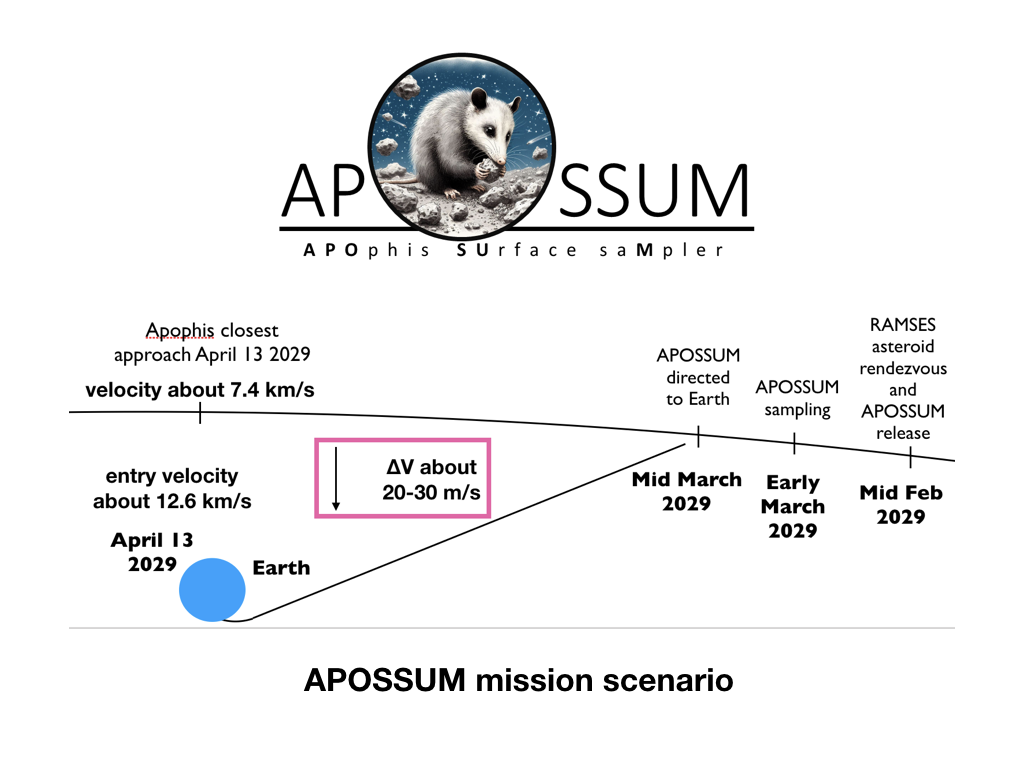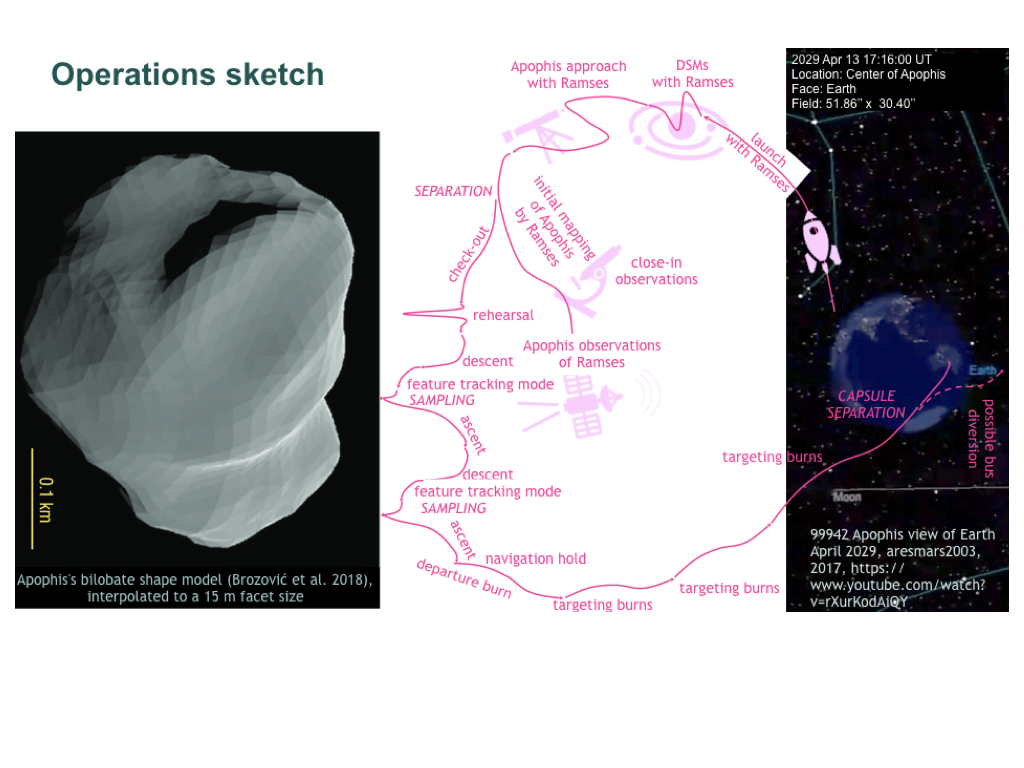- 1Max-Planck-Institut fuer Sonnensystemforschung, Göttingen, Germany (hilchenbach@mps.mpg.de)
- 2Institute of Space Systems (DLR), Bremen, Germany
- *A full list of authors appears at the end of the abstract
Introduction: A mission to (99942) Apophis would provide a unique opportunity to collect and return a regolith sample from a Near-Earth asteroid (NEA) as it passes very close to Earth [1,2]. ESA is currently investigating the possibility of an orbiter, as part of the RAMSES mission study, to fly close to (99942) Apophis before it makes its closest approach to Earth on Friday 13 April 2029, with the aim of observing the tidal and magnetospheric effects on the NEA during this close flyby [3]. Later, the asteroid will be well observed by the OSIRIS-APEX (or OSIRIS-REx Extended Mission to Asteroid Apophis) mission [4].
At present, none of these missions or mission studies are investigating the possibility of sample return with a very short duration sample return leg, requiring only a tiny additional momentum to return to Earth. We present the results of the concurrent engineering (CE) study on the feasibility of a sample return capsule based on "now-term technology" available from the space industry and the necessary mechanical, electrical and software interfaces based on the experience gained from previous small asteroid projects [5].
Overview of envisaged mission scenario baseline for APOSSUM - APOhiS SUrface saMpler: The Sample Return Probe or minisatellite should be launched as part of the RAMSES mission and be compatible with its mission requirements. We assume that RAMSES will rendezvous with asteroid (99942) Apophis in mid-February 2029. APOSSUM will be detached, land with partly autonomous navigation guidance, actively controlled by thrusters, sample the regolith, depart in mid-March 2029 and be guided towards Earth at a speed of a few tens of metres per second relative to the asteroid. This is orders of magnitude less than the speed required by previous sample-return missions because of the very close Earth flyby of (99942) Apophis on 13 April 2029. The spacecraft will cover the distance to Earth in about one month and arrive as the asteroid passes at a safe distance. The spacecraft's entry velocity is about 12.6 km/s, compared to the asteroid's 7.4 km/s fly-by, due to Earth's gravitational field. By entering the atmosphere in phase with the Earth's rotation, the entry velocity can be slightly reduced.

Design approach for Concurrent Engineering (CE) study : The development follows a tailored concurrent engineering approach that considers the compressed timeline until the envisaged launch window of RAMSES. The selected subsystems must be available as "now-term technology", similar to “off-the-shelf" components. The entry capsule and the sampler are mission-specific developments.
Brief sketch of storyline for CE study: The envisaged operations are illustrated in the Operations Sketch: After launch, communication during cruise and near (99942) Apophis is via RAMSES (high bandwidth). Direct communication to Earth will be accomplished via the RAMSES satellite. APOSSUM approaches and scouts Apophis earlier. The initial mapping/reconnaissance phase identifies possible sampling targets. Asteroid approaches begin from a home position (≈5 km altitude) under ground control, similar to Hayabusa2. Tracking of features for final approach begins from ≈1 km down, for a simple mark-and-go "contrast seeker" with horizon tracking. In the final automatic approach, this effectively locks APOSSUM to Apophis‘ slow rotation at about 5 - 10 cm/s. A toroidal rotary brush is spun up before touchdown for sampling during an inertia- and thruster-supported touch-and-go ground contact. A reversible shutter is closed on bounce-back to prevent samples from drifting out again. A lift-off burn ensures APOSSUM clears the surface; later it is accelerated to near-escape velocity towards the parking position. A rehearsal and multiple sampling attempts can be performed. Return to Earth is achieved by the departure burn and successive correction burns into the re-entry corridor, with low-bandwidth communications and ranging with Earth.

APOSSUM System Design: The spacecraft is designed around the selected entry capsule design. All other subsystems are attached and integrated. The attitude and orbit control systems are based on flight-proven cameras, sensors and propulsion units. An integrated core avionics approach using a mix of scalable on-board computers and communication equipment with off-the-shelf units such as antennae is envisaged, with new designs only where gap-fillers are needed. The outer shell of the structure provides space for thermal control and photovoltaics.
References: [1] Binzel, Richard, et al. Bulletin of the AAS 53.4 (2021). [2] Wagner, Sam, and Bong Wie. Acta Astronautica 90.1 (2013): 72-79. [3] Kueppers, Michael, et al. AAS/Division for Planetary Sciences Meeting Abstracts. Vol. 55. No. 8. 2023. [4] DellaGiustina, Daniella N., et al. The Planetary Science Journal 4.10 (2023): 198. [5] Grimm, Christian D., et al. Progress in Aerospace Sciences 104 (2019): 20-39.
Martin Hilchenbach, Oliver Stenzel, Christian Renggli, Andreas Nathues, Norbert Krupp, Henning Fischer, Thorsten Kleine, Jens Biele, Stephan Ulamec, Jan Thimo Grundmann, Tra-Mi Ho, Carsten Güttler, Bastian Gundlach, Moritz Goldmann, Nicole Schmitz, Niklas Aksteiner, Suditi Chand, Claudio Ciano, Felix Eichstaedt, Dennis Eller, Olaf Eßmann, Hannah Charlotte Feiler, Thomas Firchau, Sebastian Fexer, Pawel Goldyn, Moritz Herberhold, Victor Hernandez Megia, Christoph Kirchhefer, Hannah Kirstein, Eugen Ksenik, Michael Lange, Pascal Marquardt, Falk Nohka, Oliver Romberg, Felix Constantin Passenberg, Dominik Quantius, Anton Schneider, Rene Schulz, Fabienne Monique Seibert, Martin Siemer, Stephan Theil, Georgios Tsakyridis, Niklas Wendel, Jean-Baptiste Vincent, Torben Wippermann, Lars Witte. APOSSUM Team members are affiliated to: Max-Planck-Institute for Solar System Research, Göttingen, Germany, Deutsches Zentrum für Luft- und Raumfahrt (DLR-MUSC), Cologne, Germany, Institute of Space Systems (DLR), Bremen, Germany, Universität Münster, Institut für Planetologie, Münster, Germany, DLR Institute of Planetary Research, Berlin, Germany, DLR Institute for Satellite Geodesy and Inertial Sensing, Bremen, Germany, DLR Institute of Lightweight Systems, Brunswick, Germany, DLR Institute of Aerodynamics and Flow Technology, Cologne, Germany
How to cite: Hilchenbach, M., Kleine, T., and Grundmann, J. T. and the APOSSUM TEAM: Snatching a sample of a genuine Near-Earth Asteroid: A very swift sample return opportunity, Europlanet Science Congress 2024, Berlin, Germany, 8–13 Sep 2024, EPSC2024-98, https://doi.org/10.5194/epsc2024-98, 2024.